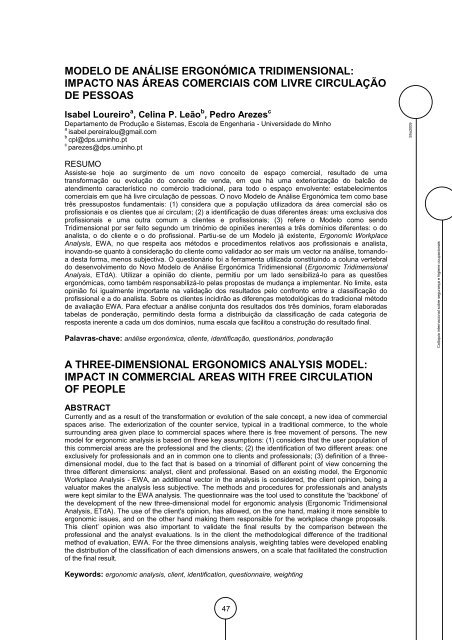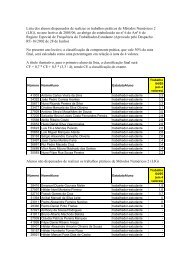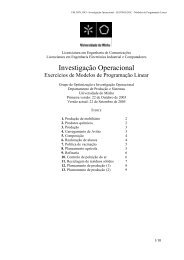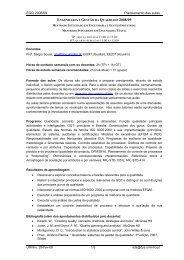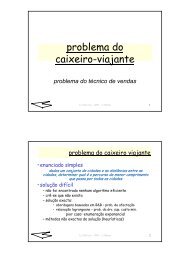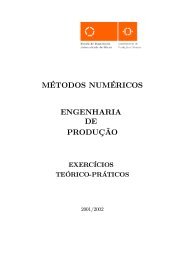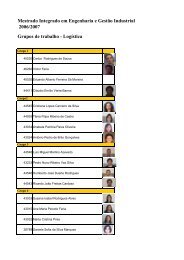- Page 2 and 3:
Sho2009SHO2009International Symposi
- Page 4 and 5:
This edition is published by the Po
- Page 6 and 7:
Index of author’s | Índice de au
- Page 8 and 9:
Oliveira. J. 85Pacciana, M. 335Pere
- Page 10 and 11:
Avaliação do risco de manipulaç
- Page 12 and 13:
PROGRAM | PROGRAMAColóquio interna
- Page 14 and 15:
Colóquio internacional sobre segur
- Page 16 and 17:
ForewordPreâmbuloThe Portuguese So
- Page 18 and 19:
PAPERS(by alphabetic order of the f
- Page 20 and 21:
A FUNÇÃO DOS DISPOSITIVOS MÉDICO
- Page 22 and 23:
- desenvolver posições nacionais,
- Page 24 and 25:
RISK EVALUATION OF HOUSEHOLD HAZARD
- Page 26 and 27:
containing lead and acids can harm
- Page 28 and 29:
People should become aware of the c
- Page 30 and 31:
GESTÃO INTEGRADA DA EMERGÊNCIA EC
- Page 32 and 33:
aeronaves; alteração ou eliminaç
- Page 34 and 35:
Tabela 8 - Avaliação do Nível de
- Page 36 and 37:
POLUENTES EMERGENTESArminda AlvesLE
- Page 38 and 39:
diclofenac - anti-inflamatório (83
- Page 40 and 41:
motoristas profissionais. Por outro
- Page 42 and 43:
UM QUADRO DE MATURIDADE ORGANIZACIO
- Page 44 and 45:
Management Association, fruto da co
- Page 46 and 47:
Os vértices da Figura 2 apontam pa
- Page 48 and 49:
26.Holliday, C.O., Schmidheiny, S.
- Page 50 and 51:
REFLEXÃO E ANÁLISE SOBRE A ORIGEM
- Page 52 and 53:
Sho2009Figura 2 - Evolução do pes
- Page 54 and 55:
assegurar a formação básica na
- Page 56 and 57:
A IMPORTÂNCIA DA SEGURANÇA NO TRA
- Page 58 and 59:
orientações que emanam do quadro
- Page 60 and 61:
DETERMINAÇÃO DA CONCENTRAÇÃO DE
- Page 62 and 63:
Sho2009Fig. 1 - Fracção total em
- Page 64 and 65:
Relativamente às concentrações o
- Page 66 and 67:
ANÁLISE DAS FONTES DE INCERTEZA E
- Page 68 and 69:
2.2 Incerteza padrão combinadaAs f
- Page 70 and 71:
ANÁLISE ERGONÔMICA DO TRABALHO EM
- Page 72 and 73:
Sho2009Figura 1 - Modelo de Perfil
- Page 74 and 75:
Sho2009Figura 5 - Profissionograma
- Page 76 and 77:
INDICADORES DE SEGURANÇA E SEU IMP
- Page 78 and 79:
trabalho que possa causar acidente
- Page 80 and 81:
Trabalho para a empresa contratante
- Page 82 and 83:
INCLUSÃO DIGITAL DE INVISUAIS: AN
- Page 84 and 85:
usado um outro programa leitor de e
- Page 86 and 87:
AVALIAÇÃO E ANÁLISE ANTROPOMÉTR
- Page 88 and 89:
Depois de estudadas as medidas actu
- Page 90 and 91:
OCCUPATIONAL HEALTH AND SAFETYMANAG
- Page 92 and 93:
Competence, training and awareness.
- Page 94 and 95:
VAMOS CONVERSAR. COMPORTAMENTO SEGU
- Page 96 and 97:
OS ESFORÇOS NOS PROFISSIONAIS DEEN
- Page 98 and 99:
Foi aplicada a distribuição não
- Page 100 and 101:
torções ou posturas de inclinaç
- Page 102 and 103:
SAFETY EVALUATION AND IMPROVEMENT I
- Page 104 and 105:
Sho2009Figure 1 - Ethylene Oxide (E
- Page 106 and 107:
SEGURANÇA NA CONSTRUÇÃOSeguranç
- Page 108 and 109:
Para cada situação e tipo de trab
- Page 110 and 111:
• Qualquer fio partido ou desloca
- Page 112 and 113:
QUESTIONÁRIO PARA AVALIAÇÃO DAS
- Page 114 and 115:
algumas adaptações ao mesmo foram
- Page 116 and 117:
9. Daraiseh, N.; Genaidy, A.M., Kar
- Page 118 and 119:
AUDITORIAS AOS SISTEMAS DE GESTÃO
- Page 120 and 121:
Os desvios podem ser positivos (faz
- Page 122 and 123:
• Melhor explicitação do concei
- Page 124 and 125:
PREVENÇÃO E MINIMIZAÇÃO DO RISC
- Page 126 and 127:
avaliadas caso a caso e de ser pond
- Page 128 and 129:
Sho2009Figura 2. Delimitação e si
- Page 130 and 131:
No entanto, há um domínio mais am
- Page 132 and 133:
FUMO DE TABACO, ESPAÇOS INTERIORES
- Page 134 and 135:
A actividade inalada pelo fumador a
- Page 136 and 137:
[5] Carvalho, F.P. (1995a). 210 Po
- Page 138 and 139:
CAPACIDADE PARA O TRABALHO DE SERVI
- Page 140 and 141:
O projeto de pesquisa foi apresenta
- Page 142 and 143:
Tabela 1.5: Correlações - Como vo
- Page 144 and 145:
OPPORTUNITIES FOR ERROR RECOVERY RE
- Page 146 and 147:
RESULTSThe potential for error exis
- Page 148 and 149:
safe for use. The introduction of c
- Page 150 and 151:
AVALIAÇÃO DO RISCO DE MANIPULAÇ
- Page 152 and 153:
como objectivos indicar aos utiliza
- Page 154 and 155:
Tabela 3. Classificação dos méto
- Page 156 and 157:
Em jeito de finalização, parece e
- Page 158 and 159:
IDENTIFICAÇÃO DAS NECESSIDADES DO
- Page 160 and 161:
elação custo-benefício das propo
- Page 162 and 163:
Três informações foram privilegi
- Page 164 and 165:
FORMAÇÃO EM CONTEXTO DE TRABALHO
- Page 166 and 167:
Suportando-nos no conhecimento adqu
- Page 168 and 169:
A transformação das condições d
- Page 170 and 171:
ENVELHECIMENTO E TRABALHO POR TURNO
- Page 172 and 173:
indicadas para a passagem para hor
- Page 174 and 175:
REFERÊNCIAS BIBLIOGRÁFICAS[1] Slu
- Page 176 and 177:
EVOLUÇÃO DA IDADE E CAPACIDADE DE
- Page 178 and 179:
Para o desenvolvimento do modelo co
- Page 180 and 181:
IMPLEMENTAÇÃO DA DIRECTIVA ATEX 1
- Page 182 and 183:
Na Directiva ATEX 137 são atribuí
- Page 184 and 185:
REFERÊNCIAS BIBLIOGRÁFICAS Comiss
- Page 186 and 187:
ENQUADRAMENTO TÉCNICO LEGAL DASACT
- Page 188 and 189:
Tal destaque implica uma qualifica
- Page 190 and 191:
estavam na agricultura, silvicultur
- Page 192 and 193:
REFERÊNCIAS BIBLIOGRÁFICAS1 Cabra
- Page 194 and 195:
FORMAÇÃO EM SEGURANÇA: UM ESTUDO
- Page 196 and 197:
segurança, à satisfação dos ind
- Page 198 and 199:
organizações que neles investem.
- Page 200 and 201:
O SECTOR SAÚDE E O IMPACTO DA PREV
- Page 202 and 203:
Além do acréscimo de preocupaçõ
- Page 204 and 205:
O Sector Saúde deve funcionar como
- Page 206 and 207:
AMBIENTE ESCOLAR: ASPECTOS DO POSTO
- Page 208 and 209:
O Gráfico 1 mostra diversos desali
- Page 210 and 211:
alunos e a queixa de dor osteomioar
- Page 212 and 213:
PERITACIÓN EN PREVENCIÓN DE RIESG
- Page 214 and 215:
FACTORES MATERIALES Y TECNOLÓGICOS
- Page 216 and 217:
daños y lesiones, de manera que en
- Page 218 and 219:
• La condiciones de seguridad•
- Page 220 and 221:
incorporadas al mismo. Dicho proced
- Page 222 and 223:
Consecuencias:• LIGERAMENTE DAÑI
- Page 224 and 225:
A FORMAÇÃO NO DOMÍNIO DA SEGURAN
- Page 226 and 227:
Nos aspectos da formação de TSHT,
- Page 228 and 229:
ANÁLISE E AVALIAÇÃO DE RISCOS NA
- Page 230 and 231:
Tabela 2 - Critérios Gravidade e P
- Page 232 and 233:
CONCLUSÕESForam identificados Peri
- Page 234 and 235:
INVESTIGATING THE EFFECTIVENESS OF
- Page 236 and 237:
Sixty percent of respondents were f
- Page 238 and 239:
PERFORMANCE OF HEARING PROTECTORS I
- Page 240 and 241:
Sho2009Fig.1 - Changes in attenuati
- Page 242 and 243:
Sho2009Figure 3 - Causes for higher
- Page 244 and 245:
PROPOSTA DE SISTEMA DE GESTÃO EM S
- Page 246 and 247:
formados 5 (cinco) ciclo de vistori
- Page 248 and 249:
de quantidade de acidentes. As orga
- Page 250 and 251:
CONFORTO TÉRMICO: ANÁLISE DOS FAT
- Page 252 and 253:
A idade média da amostra é de 25,
- Page 254 and 255:
Sho2009Tal situação pode ser expl
- Page 256 and 257:
COMO A INTEGIBILIDADE DA FALA E O D
- Page 258 and 259:
Plano AnalíticoApós a coleta dos
- Page 260 and 261:
fundamentos do nado de maneira sati
- Page 262 and 263:
ANÁLISE DOS FATORES DE RISCO À SA
- Page 264 and 265:
Com relação a manutenção dos ra
- Page 266 and 267:
sérios problemas à saúde dos mes
- Page 268 and 269:
GESTÃO DE RISCOS PROFISSIONAIS UMA
- Page 270 and 271:
iv.Avaliando a situação de risco
- Page 272 and 273:
Das posturas analisadas aplicando o
- Page 274 and 275:
MODELO DE ANÁLISE ERGONÓMICATRIDI
- Page 276 and 277:
2*Sho2009*6' 2433' 3 4! % 7Figura
- Page 278 and 279:
O Novo Modelo de Análise Ergonómi
- Page 280 and 281:
IMPLICAÇÕES DA UTILIZAÇÃO DE PR
- Page 282 and 283:
poderá ver-se envolvido numa situa
- Page 284 and 285:
acontece quando os sujeitos não ut
- Page 286 and 287:
FACETAS DA SEGURANÇA CONTRA RISCO
- Page 288 and 289:
Considerando que na inauguração d
- Page 290 and 291:
Tabela 5 - Reacção ao fogo.M0M1M2
- Page 292 and 293:
RISCO ASSOCIADO À EXPOSIÇÃO A VI
- Page 294 and 295:
A norma ISO 2631-1 [4] propõe os s
- Page 296 and 297:
A AVALIAÇÃO DE RISCOS NA FORÇA A
- Page 298 and 299:
CríticoEste nível é considerado
- Page 300 and 301:
Quadro 2 - Matriz do RiscoProbabili
- Page 302 and 303:
ANALYSING MSD RISK TO BLOCKLAYERS W
- Page 304 and 305:
The mean age of subjects was 37(12)
- Page 306 and 307:
ACKNOWLEDGEMENTSThis work was suppo
- Page 308 and 309:
NO CAMINHO DOS ZERO ACIDENTESJoão
- Page 310 and 311:
A Segurança fora do local de traba
- Page 312 and 313:
Realçaremos que a taxa de sinistra
- Page 314 and 315:
ERGONOMIA NA PREVENÇÃO DE LESÕES
- Page 316 and 317:
− Dimensionamento e Concepção d
- Page 318 and 319:
PROMOÇÃO DA PREVENÇÃO E SEGURAN
- Page 320 and 321:
METODOLOGIAA investigação contemp
- Page 322 and 323:
O professor enquanto homem “é um
- Page 324 and 325:
CONTRIBUTOS PARA O ESTUDO DO RUÍDO
- Page 326 and 327:
De cada conjunto de salas com as me
- Page 328 and 329:
65Sala 322 (JF+PA)65Sala 322 (JF+PF
- Page 330 and 331:
ABORDAGEM À PROBLEMÁTICA DA ILUMI
- Page 332 and 333:
Tabela 1: Resultados das medições
- Page 334 and 335:
foram maiores nos lugares perto da
- Page 336 and 337:
WORKERS’ TRAINING: A TOOL TO IMPR
- Page 338 and 339:
new starters, maintaining or updati
- Page 340 and 341:
OPERAÇÕES DE REABILITAÇÃO DE ED
- Page 342 and 343:
• a desvalorização das questõe
- Page 344 and 345:
4. CONCLUSÕES FINAISA intensifica
- Page 346 and 347:
TAREFAS DE MANIPULAÇÃO DE CARGAS:
- Page 348 and 349:
de Movimentação Manual (Força re
- Page 350 and 351:
BIBLIOGRAFIA1. Takala, J. (2007) Li
- Page 352 and 353:
A CHAVE DO SUCESSO DA AVALIAÇÃO D
- Page 354 and 355:
Nesta fase, para além dos trabalha
- Page 356 and 357:
A ideia de que os recursos humanos
- Page 358 and 359:
COOPERAÇÃO - NOVO PARADIGMA PARA
- Page 360 and 361:
Ilustração 4 - Fases do Processo
- Page 362 and 363:
estudos empíricos que suportem ou
- Page 364 and 365:
CONFORTO TÉRMICO EM SALAS DE AULAS
- Page 366 and 367:
Análise descritiva dos sujeitos da
- Page 368 and 369:
3) A sensação térmica dos profes
- Page 370 and 371:
AVALIAÇÃO DA EFICÁCIA DA HIGIENI
- Page 372 and 373:
A recolha de dados realizou-se em d
- Page 374 and 375:
Figura 2 - Total de Fungos ao longo
- Page 376 and 377:
AVALIAÇÃO DA CULTURA DE SEGURANÇ
- Page 378 and 379:
Quadro 1 - Avaliação do Clima de
- Page 380 and 381:
REFERÊNCIAS BIBLIOGRÁFICAS[1] Int
- Page 382 and 383:
A SEGURANÇA INDUSTRIAL NO QUADRO E
- Page 384 and 385:
Implementação e aplicaçãoA prim
- Page 386 and 387:
Salienta-se, no âmbito dos trabalh
- Page 388 and 389:
Artº 19º - Direito de votoArtº 2
- Page 390 and 391:
ANÁLISE DAS CAUSAS QUE ORIGINAM AC
- Page 392 and 393:
Tabela 2 - Faixa etária dos profis
- Page 394 and 395:
Tabela 7 - Local da lesão resultan
- Page 396 and 397:
UMA ABORDAGEM À UTILIZAÇÃO DOSEQ
- Page 398 and 399:
Este estudo teve por objectivo veri
- Page 400 and 401:
REFERÊNCIAS1 Lilja G, Wickman M (1
- Page 402 and 403:
CULTURA DE SEGURANÇA NA CONSTRUÇ
- Page 404 and 405:
numa óptica reflexiva sobre as sua
- Page 406 and 407:
ou seja a 1 ponto apenas, uma vez s
- Page 408 and 409:
cognitivos já anteriormente descri
- Page 410 and 411:
A SEGURANÇA E HIGIENE OCUPACIONAIS
- Page 412 and 413:
Sho2009... E cá dentroFigura 15 -
- Page 414 and 415:
EXPOSIÇÃO OCUPACIONAL A FUNGOS EX
- Page 416 and 417:
Cladosporium sp. (36,6%), Penicilli
- Page 418 and 419:
2. PASTUSZKA, J. et al. (2000) Bact
- Page 420 and 421:
EXPOSIÇÃO OCUPACIONAL AO FORMALDE
- Page 422 and 423: Os resultados obtidos compararam-se
- Page 426 and 427: Colóquio internacional sobre segur
- Page 428 and 429: Colóquio internacional sobre segur
- Page 430 and 431: Colóquio internacional sobre segur
- Page 432 and 433: Colóquio internacional sobre segur
- Page 434 and 435: Colóquio internacional sobre segur
- Page 436 and 437: Colóquio internacional sobre segur
- Page 438 and 439: Colóquio internacional sobre segur
- Page 440 and 441: Colóquio internacional sobre segur
- Page 442 and 443: Colóquio internacional sobre segur
- Page 444 and 445: Colóquio internacional sobre segur
- Page 446 and 447: Colóquio internacional sobre segur
- Page 448 and 449: Colóquio internacional sobre segur
- Page 450 and 451: Colóquio internacional sobre segur
- Page 452 and 453: Colóquio internacional sobre segur
- Page 454 and 455: Colóquio internacional sobre segur
- Page 456 and 457: Colóquio internacional sobre segur
- Page 458 and 459: Colóquio internacional sobre segur
- Page 460 and 461: Colóquio internacional sobre segur
- Page 462 and 463: Colóquio internacional sobre segur
- Page 464 and 465: Colóquio internacional sobre segur
- Page 466 and 467: Colóquio internacional sobre segur
- Page 468 and 469: Colóquio internacional sobre segur
- Page 470 and 471: Colóquio internacional sobre segur
- Page 474 and 475: Colóquio internacional sobre segur
- Page 476 and 477: Colóquio internacional sobre segur
- Page 478 and 479: Colóquio internacional sobre segur
- Page 480 and 481: Colóquio internacional sobre segur
- Page 482 and 483: Colóquio internacional sobre segur
- Page 484 and 485: Colóquio internacional sobre segur
- Page 486 and 487: Colóquio internacional sobre segur
- Page 488 and 489: Colóquio internacional sobre segur
- Page 490 and 491: Colóquio internacional sobre segur
- Page 492 and 493: Colóquio internacional sobre segur
- Page 494 and 495: Colóquio internacional sobre segur
- Page 496 and 497: Colóquio internacional sobre segur
- Page 498: Colóquio internacional sobre segur


